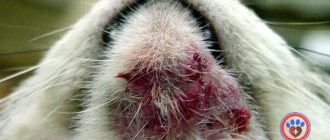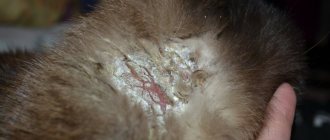Reasons for rejection
Inspecting the ear canal yourself is not difficult if you arm yourself with a small flashlight.
During the procedure, bend your ear slightly, turning it inside out. There is no need to be afraid that your pet will be in pain, since if you act carefully, the discomfort will be minimal. The inside of the ear canal must be clean, free of contamination in the form of dust or dirt. Brown bumps or black spots may indicate the presence of the disease. The table below describes the most common causes of contamination.
| Cause | Sign |
| Otodectosis (presence of mites) | The animal develops a brown coating similar to dirt in its ears. A cat with a tick is bothered by itching and inflammation |
| Sulfur plug | If a large amount of dust and dirt gets into the sink, then sulfur begins to be produced more actively. If sulfur is not removed from the passage in a timely manner, the animal begins to hear worse |
| Ear diseases | Ailments such as otitis media, fungus, allergies and infections can provoke the appearance of pollution. In the process of inflammation, purulent discharge is formed, resulting in dirt and an unpleasant odor. |
| Particles of debris and dust | If you don’t clean the sink regularly, various contaminants from the environment begin to accumulate in it. |
Quite often, a cat who lives at home and does not go outside has dirty ears. Basically, this phenomenon occurs in breeds that have no or very little hair on their ears. This natural protection prevents dust from getting inside. In this case, you should clean the ear canal more often and inspect it especially carefully for the presence of debris and foreign objects.
Characteristic symptoms
The animal cannot say in words what exactly is bothering it, so it expresses its discomfort through various behavioral actions. In the case of ticks, these will be the following symptoms:
- The cat begins to behave very restlessly, constantly jerking its head, as if trying to shake off parasites.
- He tries to get into the ear canal with his paws, gets nervous when he can’t penetrate deeper, and scratches his ears until they bleed.
- In a desire to get rid of constant itching, the cat looks for hard, stable pieces of furniture to rub its head on, or “sticks” to door frames, corners and steps.
- Dark brown and brown liquid oozes from the combed ears. An unpleasant odor appears. The pile in the lower area of the ear tassels sticks together.
- Partial or complete loss of hearing is observed.
- Body temperature rises slightly.
Important: in order not to blur the clinical picture, it is not advisable to carry out any hygiene procedures before visiting the veterinarian. You should also refrain from instilling drops or applying any ointments.
Veterinarian help
It is necessary to seek help from a specialist if you have symptoms indicating an illness. When, a few days after cleaning, a cat again has dirt in the ear canal, this fact should alert you. This sign indicates the presence of otodectosis. Mites multiply very quickly in the auricle, which provokes the presence of dirt.
The appearance of scratches on the back of the ear canal also indicates mite activity. In this case, the animal is irritated, constantly tries to scratch its ears, and shakes its head. A specialist most often prescribes acaricidal drops against parasites.
Severely dirty ears in a cat, combined with other signs, may indicate otitis media. If there is inflammation, the pet's head is constantly lowered on one side, and the cat scratches its ears until it bleeds. You cannot do without the help of a veterinarian. For a mild form of the disease, a specialist prescribes drops, and in advanced cases, antibiotics.
If your pet is acting restless, you should visit the veterinarian immediately. In advanced cases, otitis media and otodectosis can cause deafness and other dangerous pathologies. Redness and inflammation of the ear in some cases indicates the presence of infections or allergies. If you undergo a course of treatment in a timely manner, it will not be difficult to cure the animal.
Do not forget that regular examination and cleaning of the hearing organ is a good opportunity to protect your pet from dangerous pathologies. It is recommended to visit a veterinarian and undergo an examination at least once every six months. In such a case, a specialist will be able to prevent the development of dangerous diseases.
We suggest you read: How many years does a bear live?
As previously noted, consultation with a specialist is necessary when obvious symptoms of pathology appear. (or after the next cleaning, a few days later, dirt appeared in the cat’s ears again, then remove all grounds to suspect the presence of some kind of disease. Exit. Ant. The disappearance of scratches on the outside of the ear canal also indicates that not all The cat is in good health. The sign that has fallen off most likely indicates the appearance of ear parasites, in which case there are mites.
If your pet has developed otitis media, then the cat’s head will be constantly hanging down, and the sore ears will be scratched until they bleed. In such a situation, urgent veterinary treatment is needed to stop the inflammatory process. In advanced cases, the doctor usually prescribes antibiotics. Cats also need professional help if they have allergic reactions.
The owner of a domestic cat is obliged to take proper care of the animal. And cleaning and regular examination of the ears is also an excellent prevention of a number of diseases.
Associated symptoms indicating pathology
In the case when the appearance of dark dirt in the ears of an adult cat or kitten is associated with dust, in order to get rid of it for 1-2 weeks, it is enough to wipe the pet’s ears with a damp cotton pad and clean the auricle with a cotton swab. However, if after cleansing the plaque quickly accumulates again, this is a sign of the development of pathology. The table describes symptoms that occur for various reasons.
| Pathology | Characteristic symptoms | Specific signs |
| Otodectosis |
| Gradually the brown coating turns black. As the disease progresses, a lot of dark dirt appears and purulent wounds form. |
| Otitis |
| As the pathology develops, the unpleasant odor becomes more intense. In the advanced stage, the cat begins to hear poorly. |
| Sulfur plug |
| After infection enters the ear, signs of otitis media are observed. |
| Allergy |
| With allergies, unpleasant symptoms disappear or become less noticeable in the absence of contact with the allergen. |
| Fungus |
| The pet's skin becomes dry, the coat loses its shine. |
| Necrosis |
| Gradually, the cat’s condition worsens, and deformation of the auricle appears. |
What to do if your ears are dirty
For normal ear contamination, you simply need to remove debris from the ear canals. This is done like this:
- If the kitten is calm enough, you can simply sit it on a hard and flat surface. Otherwise, you need to enlist the help of a fairly strong assistant.
- You will need any veterinary hygiene lotion for ear care. You can buy it at almost any veterinary pharmacy.
- A regular pipette is also required.
- The lotion must be dripped into the ears (no more than three drops in each), and then massage the base of the ears. This is done for better distribution of the drug in the organ cavity.
- The kitten's head is tilted in different directions and they wait until the dirty lotion begins to flow out of the ear canals. If necessary, you can use cotton swabs to remove excess product (preferably with a limiter). You can't push them too far! You can only gently remove dirt from your ears with chopsticks.
- It is impossible to completely remove the lotion from the ears, but there is no need to do this: the kitten will shake out the excess itself.
But! If ear contamination at least indirectly resembles otitis media of any etiology, simple cleaning will not only not help, but will also worsen the course of the disease! If there is an unpleasant or even disgusting odor coming from the ear canals, you should contact your veterinarian immediately. In such cases, sick kittens are prescribed a course of antibiotic therapy, anti-inflammatory corticosteroids and multivitamins.
Treatment
If brown spots in a cat’s ears appear due to illness, then the treatment will be determined by a veterinarian:
- Otodectosis. Mechanical cleaning of mites, crusts, plaque using antiseptics (hydrogen peroxide, Furacilin, camphor alcohol). Treatment with an acaricidal agent (Ivermectin, Stronghold, Otoferanol, Acaromectin) in the form of drops and ointments. After applying the medicine, the ears are easily massaged to absorb the medicinal components. To stimulate the immune system – Immunofan, Ribotan. The cat is transferred to balanced feeding. If a purulent infection develops, use antibiotics.
- Otitis. Cleaning the ear surface and external auditory canal from secretions, crusts, dirt with an antiseptic solution (Chlorhexidine, Miramistin, Furacilin, hydrogen peroxide). Then the medicine is instilled (Aurikan, Surolan, Otibiovet, Tsiprovet). For purulent otitis - antibiotics (Amoxiclav, Cefazolin, Azithromycin). To stimulate the body's defenses - Gamaprene, Salmozan.
- Fungal diseases. After cleaning, antifungal ointments are used - Clotrimazole, Panolog, Oridermil. Oral medications are prescribed - Ketoconazole, Amoxicillin.
How to clean your child's ears yourself?
Before you begin the cleaning process, stock up on the necessary supplies:
- Cotton swabs – 3-4 pcs. per ear canal.
- Towel – for fixing the animal during the procedure.
- A special cleaning gel will help to act as delicately as possible on the ear canal.
If you need to clean your cat's very dirty ears, use the following scheme:
- Gently twist and bend the cat's ear. Dip a cotton swab into the gel and begin to process the passage;
- Do not insert the stick completely into the auricle, but move it literally 1 cm;
- Try to move the stick from the middle and outward, and not inward. Otherwise, you'll just be pushing more sulfur into the middle.
Before starting the procedure, try to secure your pet with a towel so that it does not run away and cannot scratch you. Perform all movements slowly and as carefully as possible. During the cleaning process, do not be afraid that you will pierce the eardrum with a stick, since you will not be able to reach it (if you do not insert the object as deeply as possible).
Diagnostic methods
When making a diagnosis, the veterinarian examines the animal's ears using an otoscope. If a tick infestation is suspected, a scraping of dark plaque is taken and examined under a microscope. Other diagnostic methods are also used:
- collection of secretions for bacteriological analysis;
- testing for allergic reactions;
- blood test to determine the general condition of the cat’s body;
- cytological examination of the contents of the auricle.
If, after testing, it is not possible to determine the exact cause of the abnormalities, the veterinarian will order an x-ray to rule out the formation of a tumor. In difficult cases, CT and MRI are performed, which can reveal the spread of inflammation to neighboring organs.
Treatment options
Effective medicines to combat ear mites are insecticide-based products. The only point that needs to be taken into account is that they act specifically on living parasites, but are absolutely not effective in killing larvae. Since the incubation period of infection is 21 days, the course of therapy should last at least three weeks, covering the entire life cycle of the tick.
- Drops. Most often, the following drugs are prescribed: Tresaderm, Ivomek, Bars, Amitrazine Plus, Otoferonol Gold, Tsipam. The advantage of using Tresaderm is that the antibiotic included in its composition affects not only the adult tick, but also its eggs, and at the same time fights fungi and other infectious inflammations. The drug Ivomec can be prescribed in the form of injections and injected into the animal according to a schedule several times a month. The remaining drops from the above list tend to affect worms if they are present.
Important: so that the cat does not get nervous during instillation, the liquid must be slightly warmed up.
- Ointments (aerosols). Aversectin ointment works well in practice, which is applied to the ear with a special spatula and is well absorbed into the skin during rubbing. Amit ointment, made on the basis of amitraz and prednisolone, has a similar acaricidal effect. Disinfection of the ears is carried out twice a day for 5 days. A cotton swab is lubricated with a creamy substance and then gently rubbed into the skin. Acaromectin spray, sprayed onto the inner surface of the ear according to the attached instructions, is effective against otodectosis.
A doctor may also prescribe Stronghold, Frontline or Oridermil, but these drugs are contraindicated for use as self-medication - only on the recommendation of a veterinarian. For preventive purposes, the drug Revolution for Cats is often prescribed - It is applied to the withers using a drop method. After absorption into the skin, the active substance acts simultaneously on both ticks and fleas, if any.
Otodectosis
All of the above reasons for ear contamination account for no more than 30% of all cases. Everything else is otodectosis. This is a tick-borne disease. Ticks and their larvae live in the ear canal of kittens, feeding on pieces of skin and blood. As a result of their vital activity, a brownish-red plaque of lumpy consistency accumulates in the ears.
Sick animals constantly shake their heads and scratch their ears with their paws. If there is exudate, it scatters throughout the room, and the smell in the room is corresponding.
Most often, antiparasitic drops are used for treatment. For kittens it is recommended to use the following varieties:
- Decta.
- Otoferonol Premium. We would recommend this particular medicine, as it has a powerful anti-inflammatory and antiparasitic effect.
- Frontline. Another high-quality and effective drug, the safest for kittens.
The exact dosage depends on the size of the kitten and the type of product, but they are used in the same way:
- The baby, as described above, is placed on a hard and flat surface.
- The required volume of drops is instilled into each ear and the base of the auricle is also massaged.
There is no need to remove anything from your ears! To make the treatment as effective as possible, before using medicinal drops, we strongly recommend cleaning your ears with hygiene lotion to remove “deposits” of mite waste products.
Since otodectosis is often accompanied by inflammation, animals are usually prescribed the same antibiotics and antifungal drugs, as well as antihistamines. The latter are needed because parasite secretions are powerful allergens, without neutralizing the effects of which it will not be possible to relieve your pet of itching and discomfort.
Dirty ears on a cat are one of the main signs of the presence of ear mites. This microscopic-sized parasite lives on the ears of many animals.
Infection
A pet can contract the disease:
- in close contact with infected individuals;
- at the moment of contact with the things of a sick dog or cat;
- at home, if the owner accidentally “brought” a tick on his clothes or things.
The tick, attaching itself to the cat’s body, moves towards the auditory organ. In the auricles, the parasite begins its active activity - feeding on the epidermis of the animal, releasing metabolic products, and multiplying at high speed. Liquid is released on the surface of the tissues of the ears in the affected areas. As it hardens, it turns brown. It is the dried droplets that constitute the notorious dirt.
Treatment
There are different ways to get rid of otodectosis. Only a doctor can prescribe the correct treatment. A preliminary diagnosis is made based on a scraping taken from the ears. When drawing up a treatment regimen, the veterinarian will take into account the concomitant condition of the pet and eliminate the harmful effects of drugs if there are contraindications.
We suggest you read: A cat scratches its neck, head or ears until it hurts, what to do, how to treat it
Insecticidal sprays are used as effective means of controlling mites. Apply the medicinal composition to the affected area – the ears. If the parasites have spread to the cat’s body, the liquid is sprayed onto the withers so that the animal cannot lick off the medicine. The breeder can also use ointments or drops.
The ointment is applied to the previously cleaned inner surfaces of both ears. Drops are measured with a special pipette - exactly in the amount prescribed by the doctor. When it comes to purchasing a medicinal product, the choice is based on the recommendations of a veterinarian. You can cure a cat for ear mites using various formulations:
- Aversectin ointment.
- Drops "Amit", "Dekta", "Dana" and "Amitrazine".
- Spray "Acaromectin", "Ivermec".
- “Ivermek gel”, “Amidel-gel”.
- Con.
If the choice is between ointment, drops and spray, then it is recommended to buy the latter of the listed forms. In this case, you can treat not only the diseased area of the body, but also the place where the pet is located - a box or bedding.
How to treat a cat at home, depending on the cause of black ears?
Treatment is prescribed based on the diagnosis and accompanying symptoms. Before starting treatment procedures, the cat’s ears are cleaned of discharge. Use cotton swabs for cleaning. The plaque is first softened with Vaseline oil. It is necessary to remove accumulations formed on the surface of the ear, and discharge located at a depth of 1 cm in the auricle. Basic methods of treating cats at home.
Ear sanitation
| Disease | Main method of treatment | Additional events |
| Otodectosis |
| If an infection is added to the underlying pathology, the cat is prescribed antibiotics. |
| Otitis |
| Cleaning the ears with hydrogen peroxide, adding vitamin and mineral complexes to food. |
| Sulfur plug | If there is no infection, no specific treatment is required. | Softening sulfur plugs with hydrogen peroxide. Keeping your ears clean. |
| Allergy |
| In difficult cases, steroids are used. During treatment, the pet’s diet is strictly monitored. |
| Fungus |
| The use of antiallergic drugs that reduce the symptom of itching and painkillers. |
| Necrosis |
| Balanced diet, vitamins and minerals. |
How to properly clean a cat's ear
Ear cleaning should be taught from childhood, so after 2 months the kitten is ready for the first procedure.
If you feel afraid or unsure of your own abilities, take your baby to the veterinarian. He will ensure safety and demonstrate basic steps.
Adhere to the following rules:
- Create a positive association . Cats have associative thinking. Cleaning your ears is an unpleasant procedure, so mix it up with pleasant memories. Play with your kitten before brushing and be sure to give him a treat after you finish.
- Prepare everything you need in advance . Finding the right item in the middle of the procedure will result in dissatisfaction with the mustache and new battle wounds.
Basic cleaning kit includes:
- Cotton buds . Do not use homemade inventions that can damage your pet's ears. To remove dirt you will need about 3-4 sticks, and as a preventative measure 1-2 will be enough.
- Ear gel . A special product allows you to effectively clean dirt and does not cause an allergic reaction. Do not use alcohol-containing or drying solutions. They injure the inner ear, causing the growth of ulcers and suppuration.
- Towel . The soft tissue acts as a straitjacket, preventing accidental injury.
A kitten should be taught to clean its ears from childhood.
The direction of movements should be outward, otherwise the accumulated wax will push deeper and form a plug.
For safety, perform the procedure together. One person will be able to hold the animal, and the second will be able to concentrate as much as possible on cleaning.
Don't be afraid to injure your eardrum. It is located deep in the auricle, so harm to it is possible only with deliberate impact. However, be careful and do not make sudden movements, because you can still cause discomfort.
To keep your ears clean, it is enough to clean them 1-2 times a month. At the same time, owners of large-eared or hairless cats will have to increase the frequency.
Rules for the use of medicines
The sequence of actions during therapy should be as follows:
- Before dripping or applying ointment, it is necessary to clean the ear surface of all dirt, crusts and purulent discharge. This is done with a cotton swab soaked in camphor alcohol (2%) or hydrogen peroxide. Alternatively, you can use other disinfecting lotions designed for ears.
- When all the impurities become limp and “move away” from the skin, they can be easily removed with a cotton swab. Often the cat itself “shakes out” all the dirt from its ears with its paws.
- In order for the medicine to get deep into the ear canal and be well absorbed, you need to massage the base of the ear with light movements.
- The dosage of the medicine must strictly comply with the instructions or doctor’s prescriptions.
- If there is another cat or other animals living in the house, it is recommended to ventilate living areas more often and do wet cleaning during the treatment period. In this way, the likelihood of re-infection and infection of healthy pets is reduced.
Prevention of ear diseases in cats
To prevent ear pathologies, the owner needs to regularly clean the pet’s ears. You must also adhere to the following recommendations:
- Avoid getting water into your cat’s ears while bathing;
- preventive examination by a specialist every 6 months;
- contacting a veterinarian if alarming symptoms are detected;
- treat the coat with antiparasitic agents;
- isolate your pet from allergens;
- Avoid contact of the domestic cat with possible sources of infection (yard cats, birds, rodents, sick animals).
Share with friends!
What is an ear mite and where does it live?
The main “locations” of ear mites are the ear canal, the tympanic septum and the outer area of the concha. The breeding ground for parasites and their larvae is sulfur. In rare cases, ticks can be found directly on the animal's head. First of all, cats with weakened immune systems are at risk, especially when kept in a crowded environment, as well as kittens under one year of age. The disease is considered highly contagious and can be transmitted to other pets, although in rare cases.
A person himself can become a carrier of otodectosis by bringing home parasite larvae on the soles of shoes or clothes. Another possible infection option is contact with contaminated rugs, trays, dishes and other everyday items. Flies and fleas can also be “conductors” of the disease.
The tick cannot be seen with the naked eye due to its very small size. It can only be seen under a magnifying glass or microscope by taking a smear from the affected area. The insect has an average size of 0.2-0.7 mm in length, a short body of pale yellow color and elongated limbs.
It feeds on sulfur mass, dumping its biochemical secretions and blood remaining after bites there. As a result, a dark coating of a granular structure forms on the surface of the ear, which is used to initially diagnose the presence of the parasite.
Many diseases, including ear diseases, are usually classified, which is not only an effective method of organizing knowledge, but also facilitates the diagnostic process. The distribution of diseases is often based on characteristics such as the causes of the problem and the degree of its danger to others.
Ear diseases fall into one of three groups:
- Infectious. The main source of diseases of this kind is pathogenic microorganisms such as fungi and bacteria. They are predominantly contagious and are transmitted from sick cats to other animals respiratoryly or contagiously. People are also at risk, especially if they allow their pets to sleep on the same pillow as them.
- Invasive or parasitic. Such diseases are caused by life forms that use the organisms of other creatures as habitat. Known parasites include helminths, fleas, ticks and other insects.
- Non-contagious. Based on the name, they are not transmitted to humans or other animals. They can be caused by external and internal factors that are not infectious or invasive in nature.
When to contact a veterinarian
In some cases, you won’t be able to deal with dirty ears on your own.
A veterinarian's help will be required if:
- the appearance of a specific unpleasant odor;
- regular nature of pollution;
- attempts to keep your head tilted to one side;
- lack of reaction to extraneous sounds and one’s own name;
- the appearance of pus and blood;
- lethargy and apathy, accompanied by a refusal of active games;
- severe itching, forcing you to scratch your ears until they bleed;
- the occurrence of redness, swelling and local fever;
- an abundance of dark-colored discharge and accumulation of sulfur;
- pain when trying to touch the ears;
- loss of balance and other coordination problems.
In case of otodectosis, it is necessary to show the kitten to a veterinarian
These symptoms often indicate the presence of otodectosis. For kittens, the disease is especially dangerous due to their weak immune system. In the absence of timely treatment, the disease worsens and causes otitis media. A small kitten may not only lose hearing, but also die.
If you notice alarming symptoms, it is important to seek qualified help. Treatment of otodectosis is difficult only in advanced conditions.
For an effective result, it is important to pre-clean the cat’s ears and then apply the prescribed medicine.
The disease is fought with:
- ear cleaners;
- ear ointments and drops;
- insecticidal sprays or drops.
A sick pet needs to have its ears cleaned daily to free up access to the skin.
Remember the importance of preventative cleaning. Proper hygiene will protect the health of your little pet and ensure good hearing.










